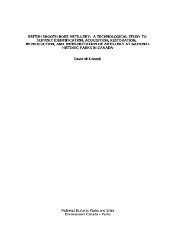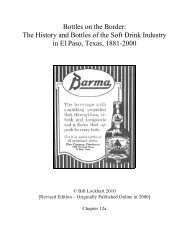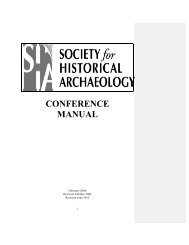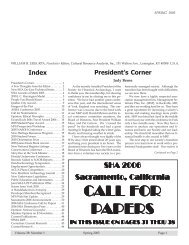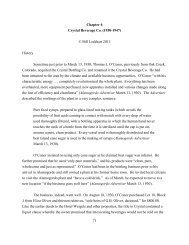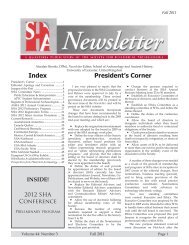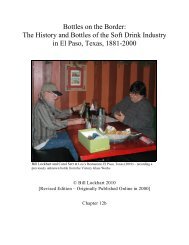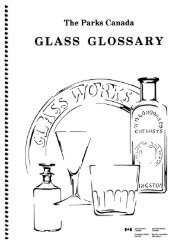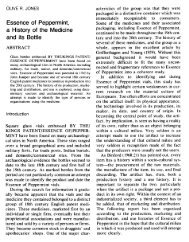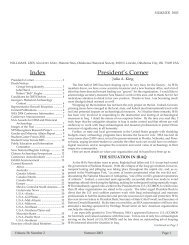Bottles on the Border: The History and Bottles of the Soft Drink ...
Bottles on the Border: The History and Bottles of the Soft Drink ...
Bottles on the Border: The History and Bottles of the Soft Drink ...
You also want an ePaper? Increase the reach of your titles
YUMPU automatically turns print PDFs into web optimized ePapers that Google loves.
Hutchins<strong>on</strong> bottle used at Douglas, Ariz<strong>on</strong>a. Even <strong>the</strong> style <strong>of</strong> lettering in <strong>the</strong> circular plate<br />
matches (see Douglas discussi<strong>on</strong> below).<br />
Houck & Dieter Crown-Finished Bottle<br />
Sometime (probably about 1898 or earlier) Houck & Dieter switched to <strong>the</strong> crown cap as a<br />
sealer, a process that probably began about 1898 (possibly as early as 1895). Houck & Dieter’s<br />
major competitor, R.F. Johns<strong>on</strong> & Co., adopted a crown-finish bottle sometime between 1895<br />
<strong>and</strong> 1898 (see R.F. Johns<strong>on</strong> & Co.). <strong>The</strong> company very likely used <strong>the</strong> earliest crown-capped<br />
c<strong>on</strong>tainers simultaneously with <strong>the</strong> last <strong>of</strong> <strong>the</strong> Hutchins<strong>on</strong> bottles. This was apparently a fairly<br />
comm<strong>on</strong> practice. Elliott & Gould (1988:44) explain:<br />
Though many bottlers made <strong>the</strong> switch from Hutchins<strong>on</strong>s to crowns at some<br />
point during this period a number <strong>of</strong> <strong>the</strong>m retained <strong>the</strong>ir Hutchins<strong>on</strong> machinery<br />
<strong>and</strong> c<strong>on</strong>tinued to use Hutchins<strong>on</strong> bottles as well as crowns. This was practical for<br />
two reas<strong>on</strong>s. First, <strong>the</strong> bottler’s existing Hutchins<strong>on</strong> machinery represented a<br />
large investment that was still perfectly good; <strong>and</strong> sec<strong>on</strong>dly, people tend to resist<br />
change, <strong>and</strong> a whole generati<strong>on</strong> had grown accustomed to drinking from <strong>the</strong><br />
Hutchins<strong>on</strong> bottles.<br />
When making bottles for soda works that used both Hutchins<strong>on</strong>s <strong>and</strong> crowns<br />
<strong>the</strong> glass houses generally made a dual set <strong>of</strong> molds or plates, <strong>on</strong>e for <strong>the</strong><br />
Hutchins<strong>on</strong>s <strong>and</strong> <strong>on</strong>e for <strong>the</strong> crown tops, so that both types <strong>of</strong> bottles could be<br />
clown simultaneously, speeding producti<strong>on</strong>. <strong>The</strong> same design was usually cut into<br />
each plate <strong>and</strong> if <strong>the</strong> engraver was doing fine work <strong>the</strong> lettering <strong>on</strong> <strong>the</strong> resulting<br />
Hutchins<strong>on</strong>s <strong>and</strong> crowns, though never quite identical, was <strong>of</strong>ten very similar.<br />
<strong>The</strong> later Houck & Dieter Hutchins<strong>on</strong> bottles are not a match with <strong>the</strong> crown-capped bottles. <strong>The</strong><br />
styles <strong>of</strong> lettering are quite different. In fact, <strong>the</strong> shape <strong>of</strong> <strong>the</strong> lettering <strong>on</strong> <strong>the</strong> fr<strong>on</strong>t <strong>and</strong> <strong>the</strong> lack<br />
<strong>of</strong> plate mold are a very close match for <strong>the</strong> older, original Hutchins<strong>on</strong> (Mat<strong>the</strong>ws) bottle (Figure<br />
5-23).<br />
Method <strong>of</strong> Manufacture: Blown into mold<br />
Color: Light Blue<br />
Size (in cm.): 19.8-20.3 (h); 6.5-6.6 (d)<br />
Primary Labeling Style: Embossed<br />
89



